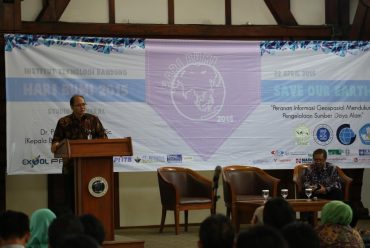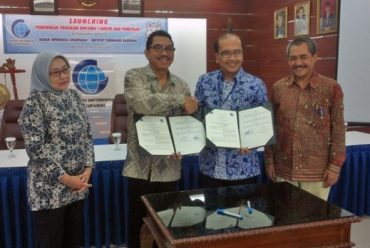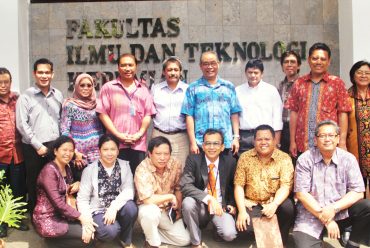Campus Courses Earth Karst Citatah
Bandung 1929. How great city of Bandung in its golden age when still remembered as Parijs van Java. The city has successfully hosted the Fourth Pacific Science Congress. Various scientists from the fields of science around the world gathered in Singapore at the time, among them geologists, who not only come from the Pacific Rim, as well as Europe, and of course particularly the Netherlands.
The papers are now a classic article on Indonesian geology presented at the congress. Some of them are writing about the analysis of obsidian (volcanic glass) from Mount Kiamis, Garut, by a volcano researcher Neumann van Padang. Another paper published in the same year of the Bandung Basin and the existence of Bandung Purba Lake by Stehn and Umbgrove. Bandung Basin map to be attached to the paper as a reference further research, especially by paleontologists G.H.R. Koenigswald discussing the distribution of obsidian tools around Bandung Ancient Lake on the German-language writings, 1935.
At the congress was also a geologist researcher named Harting argued sedimentary rocks of ancient coral reefs that lived 30 million years ago, who was called as a layer Tagogapu, and is now known as Formation Rajamandala, in Padalarang. In fact, one of the goals of the congress travel widya is visited karst area Citatah, Padalarang. So, from the scientific Geology, karst areas Citatah how important that has been introduced to the international world since Indonesia is not yet independent.
What was the condition of karst Citatah now? Mount Masigit being the location or the type of referral limestone formations studied Rajamandala participants IV Pacific Science Congress 1929 is now screaming wail sky, shouting penetrate the universe. The mountain shattered body detonated dynamite flurry, or pried excavator arbitrary. Now it appeared outcrop hill-white craggy outcrop with gaping holes, leaving nearly 50% compared to its original condition.
Additional limestone hills, sand disasters seemed gaping tragic when viewed from the highway towards Cianjur to Bandung. Leuit sand and sand-Ketu Ketu, almost flush with the surrounding ground surface. Sand Bengkung with igir (back) the hill like a giant tooth next to the so-called Coral Panganten appear to be intact when viewed from the side of the highway Bandung-Cianjur in Pamucatan, but on the contrary, the white cliffs of excavation increasingly mempertipis igir hill. Sand Cliffs Pabeasan also called 125, or sand Manik (Tebing 49), is still intact as diligent made the event rock climbing. But around him, morphology ravaged become a daily sight.
Very pathetic anyway, the only unique karst morphology and rare in other countries may have been used as a national natural monument in the form of a natural arch (natural arc), threatened with collapse because of the left-right intensive dug up, blown up and destroyed. It seemed there was no hope for nature lovers who daily crawl Tebing 125 observed from week to week, the degradation of karst hills Citatah apparent beneath his feet.
From all the limestone hills that stretches from the north Tagogapu Padalarang to Cihea on the border with the West Bandung regency of Cianjur, about 80% – 90% no longer intact. Of the remainder of those few, Pasir Pawon is the only one that is still beautiful limestone hills without interruption excavation. On the hill the size of approximately 45 ha were several cave pits influx facing north. Underneath springs seeping from the cracks of limestone that never dry even in the dry season, quite a checkered irrigate rice fields in the vicinity. Two things that make this cave guarded community as a valuable natural heritage.
Maintaining the integrity of Pasir Pawon as though a fixed price after it was revealed the grave site of prehistoric man lived 9,500 years ago were found in the Cave Pawon. The preliminary study in 2000 conducted by researchers from ITB and LIPI incorporated in Bandung Basin Research Group (KRCB) paves the way for the excavation of Bandung Institute of Archaeology in 2003 up to the unraveling of the whole framework of the Human curled Pawon. The findings were spectacular cave Pawon it makes the site is the site of the first prehistoric human graves and the only one in West Java and Banten. This is an asset that should the West Bandung regency internationally in its contribution to the preparation of human evolution in the prehistoric world.
The turning point in 2009
Unfortunately, eight years since the pilot studies KRCB and five years after the unraveling of the skeleton curled up by the Archaeological Institute of Bandung, Gua Pawon should not be handled as a world-class site. Instead managed properly, Pasir Pawon in early 2008 has been targeted by three aspiring entrepreneurs limestone. Fortunately exploitation permit for the limestone was the hindrance on public awareness around the Cave Pawon so the threat of exploitation can be prevented. Moreover, when the area was under the West Bandung Regency as a division of Bandung regency, this valuable asset began to be a serious concern, particularly through Wabup Ernawan Natasaputra.
In good faith a new district government, the rescue effort continues. Citatah karst rescue team was immediately formed with SK Bupati Bandung Barat. West Java Governor Ahmad Heryawan support efforts towards the rescue site after a visit to the Cave Pawon Gunungmasigit village where the site is located. Gong of all it is a statement of West Java Deputy Governor Dede Yusuf when opening a photo exhibition “Save Karst Citatah” in Bandung Geology Museum on Thursday (19/2) that are ready to accommodate rescue efforts karst Citatah from 2009.
Dede Yusuf also who eventually took his time in between busy as deputy governor of the solid to come to the Cave Pawon. Beliaulah highest official ever to visit the Cave Pawon, climb the slopes of the cave with the fragrant smell of bat droppings, observe stalactites and stalagmites, “greet” replica Man pawon in place to be, and dialogue are familiar with the community and high school kids who happen to berdarma travel to the Cave Pawon , At that moment, Sunday (8/3), he inaugurated the Village of Arts and Culture Gua Pawon, and two days later stating that there is a moratorium on excavation in limestone karst hills Citatah.
On Sunday (5/4), West Java Provincial Government to demonstrate its commitment. The initial funds disbursed Rp 60 million for the development of Village Tourism, Art and Culture Cave Pawon. It was not a gift just for the people of Gua Pawon, but a mandate that must be carried out with the best. But at the same, dynamite explosions still occur crush limestone hillsides. The incident was as though a mockery of a moratorium on excavation effort helplessness, or maybe a race spent limestone reserves before really no strong action to stop the excavation: Beak-Beak blurred …
Campus terrestrial field
Crater Candradimuka Indonesian geologists were in Karangsambung, Kebumen, Central Java Every year students of Engineering Geological and Geophysical Engineering ITB go there and gain knowledge in the field of geology and geophysics field for two weeks to one month.
It is forced away, because there they gathered in the area adjacent various types of rock that became the main subject of geological field study. Even since 1964 has been established under the management of field campus LIPI.
Actually, Geology ITB in the early 1960s been targeting the area between Padalarang, Citatah, and Rajamandala as a campus field. Even in this place is not as rich as Karangsambung type of rock, but the learning materials more excellent Geology field. J.A. Katili (deceased) who was the first professor of Geology at the ITB and Indonesia, as written in his biography treasure the Earth Indonesia, together Prof. Sukendar Asikin, struggling to find a candidate field campus, since Singkarak in West Sumatra, Ciletuh and Padalarang in West Java and Central Java Karangsambung. Even Karangsambung finally selected, but in any case Padalarang region is one of the potential candidates.
In the development of geoscience growing in the 21st century, the region Citatah, Padalarang, returning glance to be an alternative campus Karangsambung field. The return of a candidate Citatah field campus based on several reasons. First, the proximity of Bandung. Secondly, a lot of discipline on campuses in Bandung and West Java, which inevitably requires an expanded field laboratory as a field laboratory of earth (not just geology course). At ITB alone there Geology, Geodesy, Geophysics, Meteorology even. Department of Geology in West Java are also available in Unpad, Unpak, STTMI, and AGP. Not to mention the Department of Geography at UPI.
After the discovery of archaeological sites Gua Pawon, even the Department of Archaeology of the UI or the Department of Anthropology Unpad can also make the areas Citatah as a field laboratory. Certainly in the next stage, other sciences that require field laboratory can use, sepertipertambangan, biology, agriculture, and so on.
It is not possible education-secondary education or even basic education can utilize Citatah field campus. Is not educational environment has to be given since the basic education? (Budi Brahmantyo, staff lecturer in Applied Geology KK, FITB, ITB; Head of ITB Tourism P2Par, and members of the Bandung Basin Research Group / KRCB.) ***
Author: Dr.Ir. Budi Brahmantyo, M.Sc (Geology Engineering Lecturer ITB)
Source: http://newspaper.pikiran-rakyat.com/prprint.php?mib=beritadetail&id=69317







No Comments